Removal Procedure
Caution: When working with any type of glass or sheet metal with exposed or rough
edges, wear approved safety glasses and gloves in order to reduce
the chance of personal injury.
Caution: Failure to prep the area prior to the application of primer
may cause insufficient bonding of urethane adhesive. Insufficient bonding
of urethane adhesive may allow unrestrained occupants to be ejected from
the vehicle resulting in personal injury.
Caution: At least 24 hours are required for complete curing of repair
material. The repair area should not be physically distrubed until after that
time. Insufficient curing of urethane adhesive may allow unrestrained occupants
to be ejected from the vehicle resulting in personal injury.
Caution: When replacing stationary windows, use Urethane Adhesive Kit GM P/N 12346392
(Canadian P/N 10952983), or a urethane adhesive system meeting GM Specification
GM3651G, to maintain original installation integrity. Failure to use the urethane
adhesive kit will result in poor retention of the window which may allow unrestrained
occupants to be ejected from the vehicle resulting in personal injury.
Caution: If broken glass falls into the defroster outlets, it can be blown into
the passenger compartment and cause personal injury.
Tools Required
J 24402-A Glass Sealant
Remover (Cold Knife)
- Apply masking tape to the painted surfaces around the windshield
in order to prevent damage to the paint.
- Cover the defroster openings.
- Remove the windshield wipers arms and blades. Refer to Wiper Arm
Replacement in Wiper/Washer Systems.
- Remove the air inlet grille. Refer to
Air Inlet Grille Panel Replacement
.
- Remove the rearview mirror. Refer to
Inside Rearview Mirror Replacement
.
- Remove the windshield garnish molding . Refer to
Garnish Molding Replacement - Upper
.
- Remove the windshield side reveal molding. Refer to
Windshield Side Reveal Molding Replacement
.
- Remove the windshield upper reveal molding. Refer to
Windshield Upper Reveal Molding Replacement
.
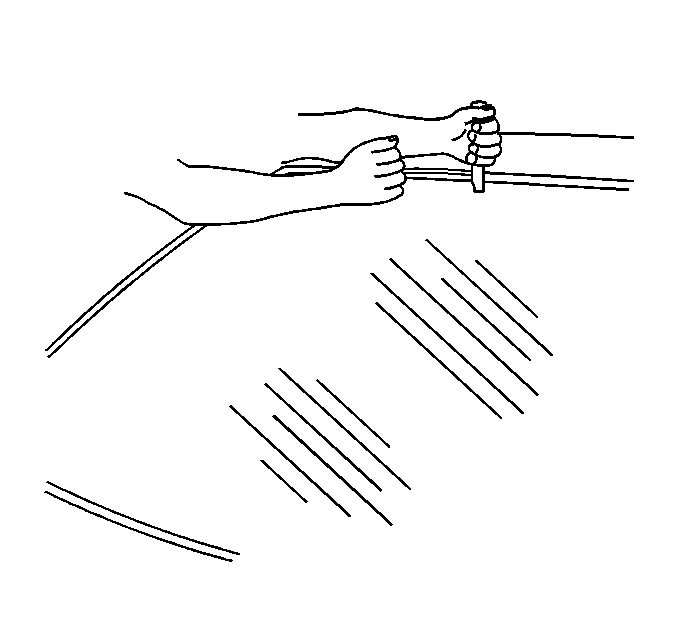
- Using a razor or utility
knife, make a preliminary cut around the perimeter of the windshield. Cut
as close to the edge of the windshield as possible.
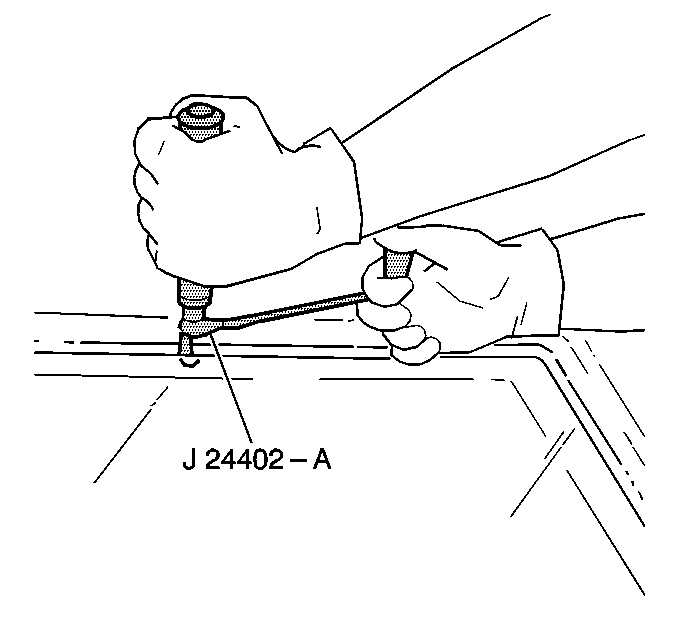
Important: Keep the cutting edge of the tool against the windshield. This separates
the urethane adhesive from the windshield.
- Cut out the windshield keeping the blade as close to edge of windshield
as possible using the J 24402-A
.
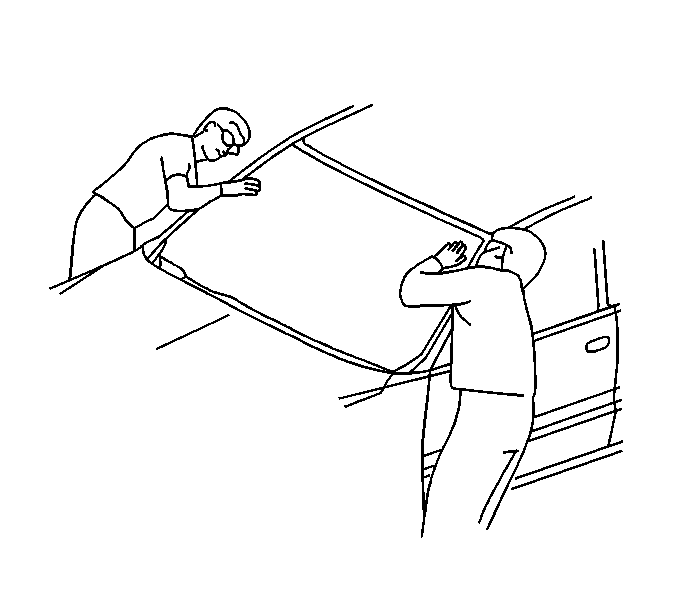
- With the aid of an assistant,
remove the windshield.
- The following components may reveal the causes of a broken windshield:
| • | The flange of the windshield opening |
| • | The windshield reveal molding |
- Look for any of the following conditions in order to prevent damage
to the windshield:
| • | Hardened spot weld sealer |
| • | Any obstruction or irregularity in the pinchweld flange |
- Inspect the condition of the windshield opening and the adhesive
bead in order to determine which installation method you will use. Refer to
Short Method Description
or
Extended Method Description
.
Important: If corrosion of the pinchweld flange is present, or if sheet metal repairs
or replacements are necessary, refinish the pinchweld flange in order to present
a clean primer only surface. If repairs to the paint are required, mask
the flange bonding area prior to the application of the color coat in
order to provide a clean primer only surface. Use material such
as BASF DE17®, DuPont 2610®, and PPG DP40®.
- After repairing the opening as indicated, perform the following steps:
- Thoroughly shake the primers that are provided in urethane adhesive
kit GM P/N 12346284, or equivalent.
- Clean the windshield and pinchweld flange with a clean, dampened
cloth using GM Window Cleaner GM P/N 1050427, or isopropyl
alcohol, in order to clean the surface of the windshield and the pinchweld
flange of the excess urethane adhesive.
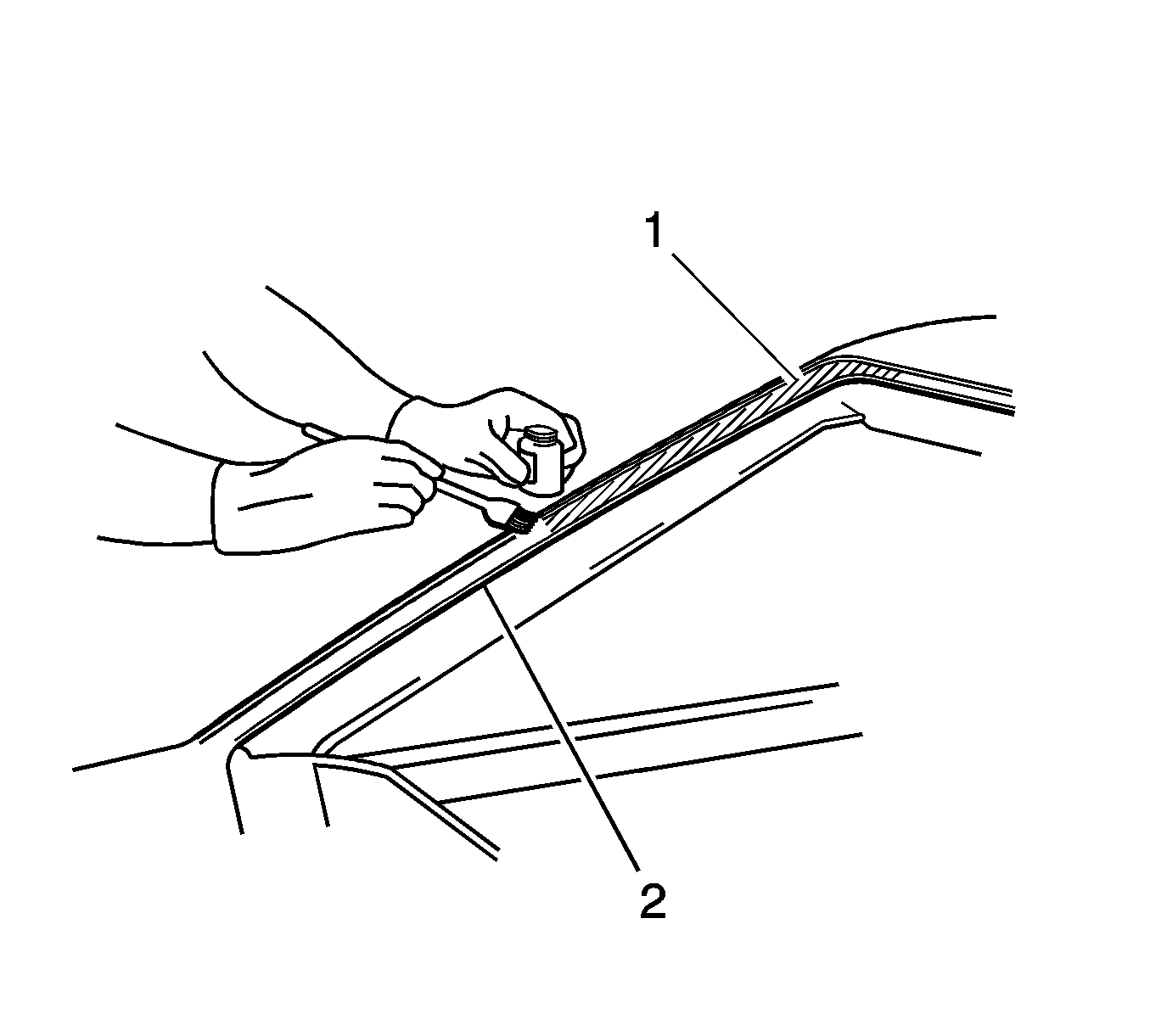
- Use a new dauber to apply
the pinchweld primer (Black #3) to the primed surface on the pinchweld
flange and to any exposed painted surfaces or any scratches in the metal
in the bonding area.
- Allow approximately 10 minutes drying time for the pinchweld
primer (Black #3).
Installation Procedure

- With the aid of an assistant,
dry fit the window in the opening in order to determine the correct position.
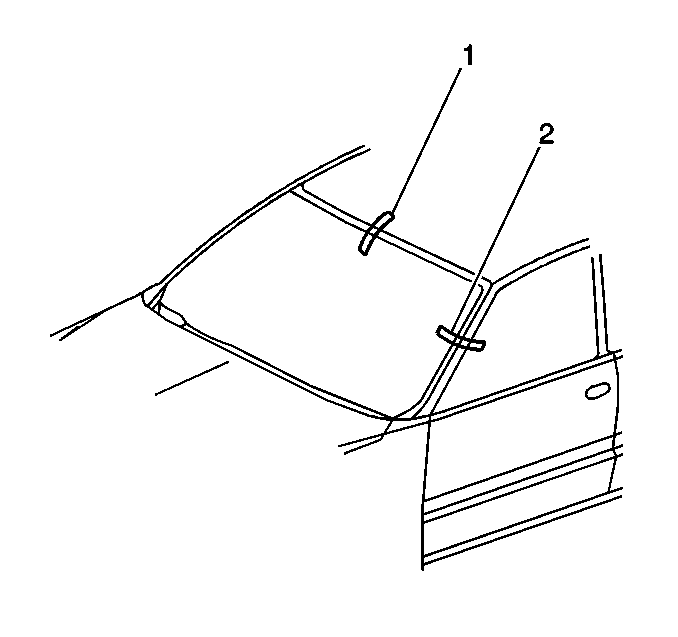
- Use masking tape in order
to mark the location of the windshield in the opening.
- Slit the masking tape at the top edge of the windshield.

- With the aid of an assistant
remove the windshield.
- Place the windshield inside up on a clean, protected surface.
- If the you reuse the original window, remove all but a thin film
of the existing urethane adhesive from the window surface, using a utility
knife or equivalent.
- Clean the inside surface of the windshield with GM Glass Cleaner
P/N 1050427, or the equivalent.
- If the extended installation method is being performed:
| 8.1. | Remove all but a thin film of the existing bead of adhesive from
the pinchweld flange. |
| 8.2. | It is not necessary to remove all the traces of the urethane adhesive,
but there should not be any mounds or loose pieces of the adhesive. |
| 8.3. | Thoroughly shake the pinchweld primer (#3 black). |
| 8.4. | Use a new dauber in order to apply the pinchweld primer (#3 black)
to exposed painted surfaces or scratches in the pinchweld flange in the bonding
area. |
| 8.5. | Allow approximately 10 minutes drying time for the pinchweld
primer (#3 black). |
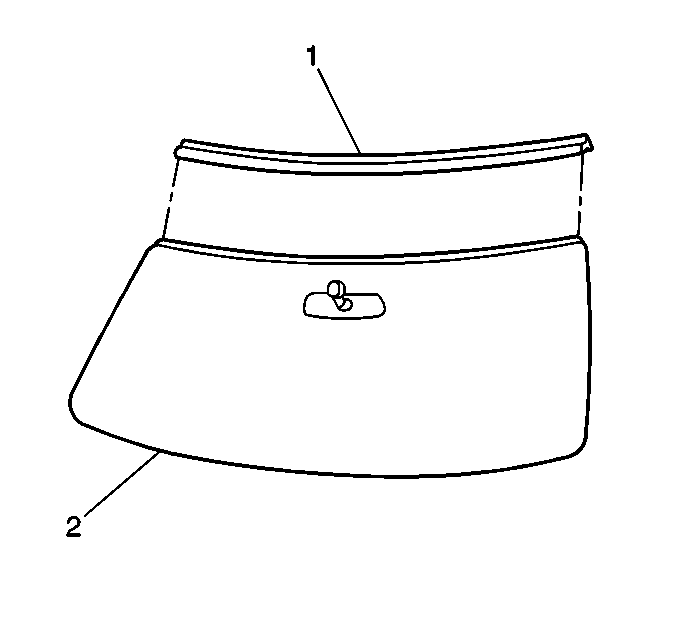
- Install a new windshield
upper reveal molding.
Important: Use care when applying the windshield prep (#1 clear) in order
to prevent the windshield prep (#1 clear) from running into the vision
area of the windshield. This windshield prep (#1 clear) may
stain the view area of the windshield. This windshield prep (#1 clear)
dries almost instantly.

- Using a new dauber, apply
windshield prep (#1 clear) to an area approximately 10-16 mm
(3/8-5/8 in) around the entire perimeter of the windshield
inner surface and to any exposed edges of the window.
- Immediately wipe the primed area with a clean cloth.
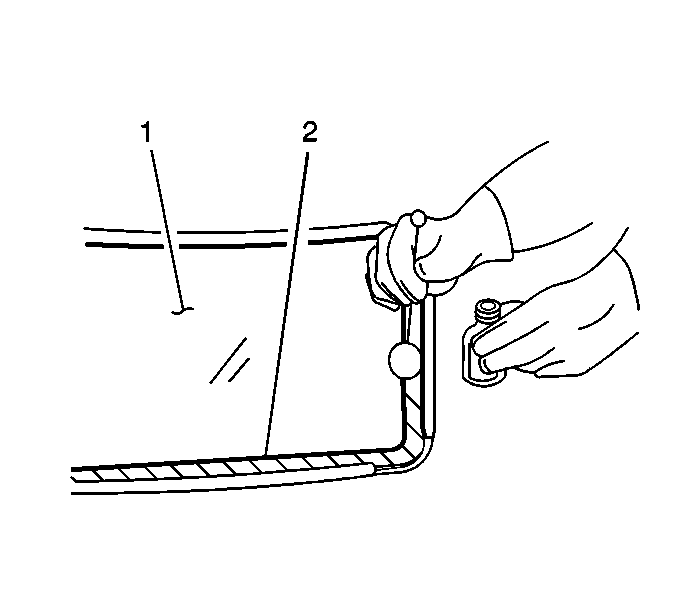
- Thoroughly shake the windshield
primer (#2 black).
- Using a new dauber, apply the windshield primer (#2 black)
to the same areas where you applied the windshield prep (#1 clear).
- Allow approximately 6 minutes for drying the windshield
primer (#2 black).
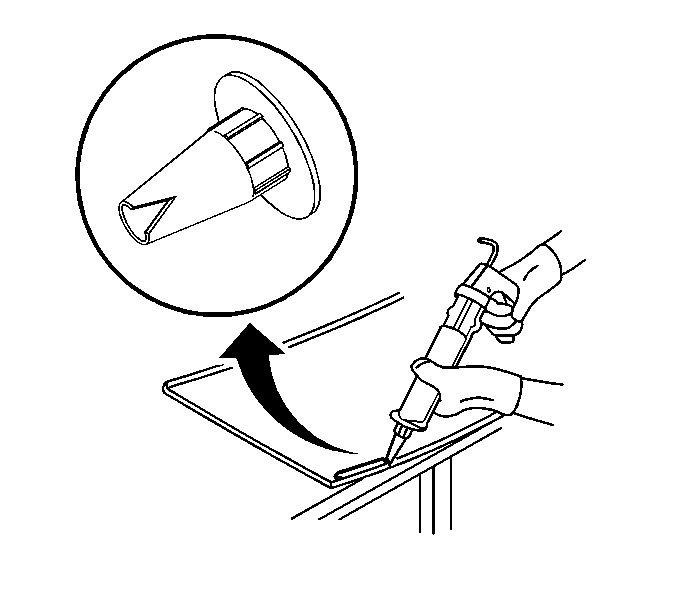
- Prior to application of
the urethane adhesive, cut the tip of the applicator nozzle in order
to provide the following bead sizes:
| • | For the short method, cut the tip in order to provide an adhesive
bead of approximately 4.5 mm (1/8-3/16 in). |
| • | For the extended method, cut the tip in order to provide an adhesive
bead of approximately 14 mm (9/16 in). |
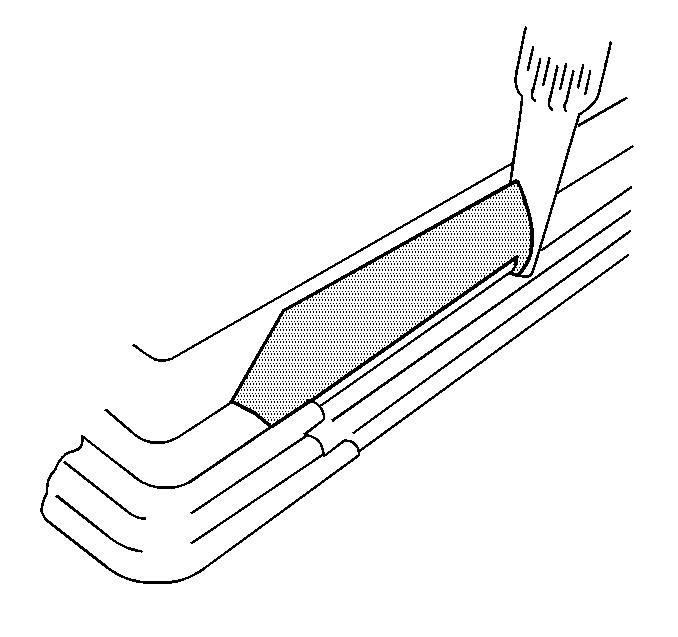
- Using a cartridge-type
caulking gun, apply a smooth continuous bead of urethane adhesive.
- When using the short installation method, apply the urethane adhesive
to the existing bead of urethane adhesive on the body.
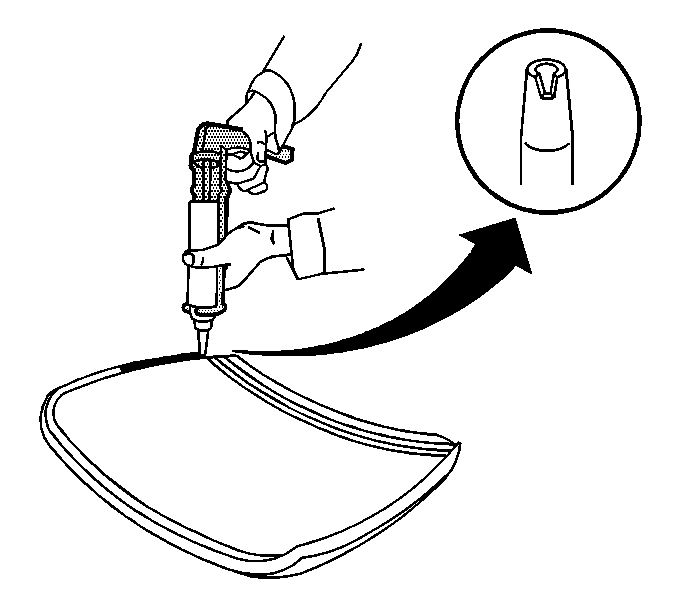
- When using the extended
installation method, use the edge of the window or the inside edge of the
reveal molding as a guide for the nozzle.

- With the aid of an assistant,
use rubber suction cups in order to install the window in the opening.

- Align the tape on the
windshield and on the body.
- Firmly press the windshield into place in order to wet-out and
seat the urethane adhesive.
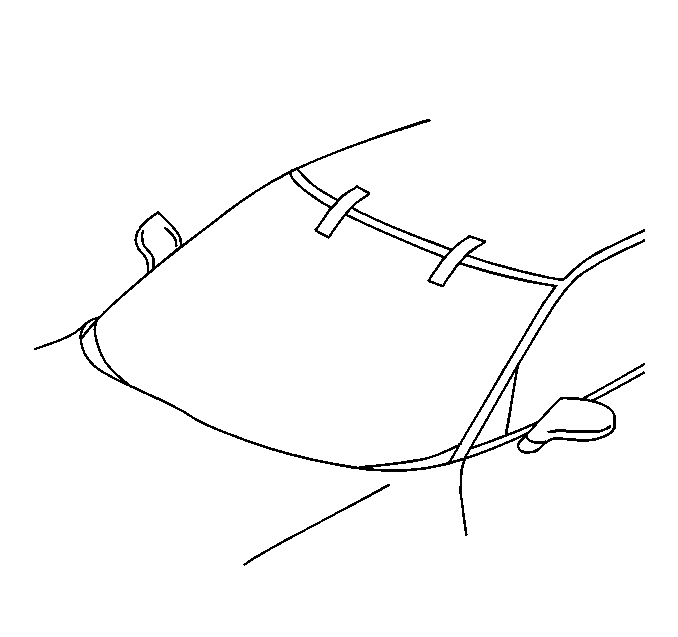
- Tape the windshield to
the body in order to minimize movement until the urethane adhesive cures.
- Remove any excess urethane adhesive.
Important: Warm or hot water accelerates the cure of the adhesive. Do not direct
a hard stream of high pressure water at the fresh urethane adhesive.
- Use a soft spray of warm water in order to immediately water test the
windshield.
- Inspect the windshield for leaks.
- If you found any leaks, use a plastic paddle in order to apply
extra urethane at the leak point.
- Complete the following steps in order to properly cure the urethane
adhesive:
| • | Keep the vehicle at a room temperature of 22° C (72° F)
at 30 percent relative humidity. |
| • | Allow a minimum of (6 hours) for the moisture curing urethane
adhesive. |
| • | Allow a minimum of (1 to 1½ hours) for the chemical
curing urethane adhesive. |
| • | Partially lower a door window in order to prevent pressure build-ups
when you close doors prior to the urethane adhesive cure. |
| • | Do not drive the vehicle until the urethane adhesive is cured. |
| • | Do not use compressed air in order to dry the urethane adhesive. |
- Install the windshield side reveal molding. Refer to
Windshield Side Reveal Molding Replacement
.
- Install the windshield garnish molding . Refer to
Garnish Molding Replacement - Upper
.
- Install the air inlet grille. Refer to
Air Inlet Grille Panel Replacement
.
- Install the windshield wipers arms and blades. Refer to Wiper
Arm Replacement
- Install the rearview mirror. Refer to
Inside Rearview Mirror Replacement
.
- Remove the protective tape and the coverings from the windshield
area .
- Wipe the windshield area with a clean, dampened cloth using GM
Window Cleaner GM P/N 1050427 or isopropyl alcohol in order
to clean the surface of the windshield of the excess urethane adhesive.
Allow the surface to air dry.
















